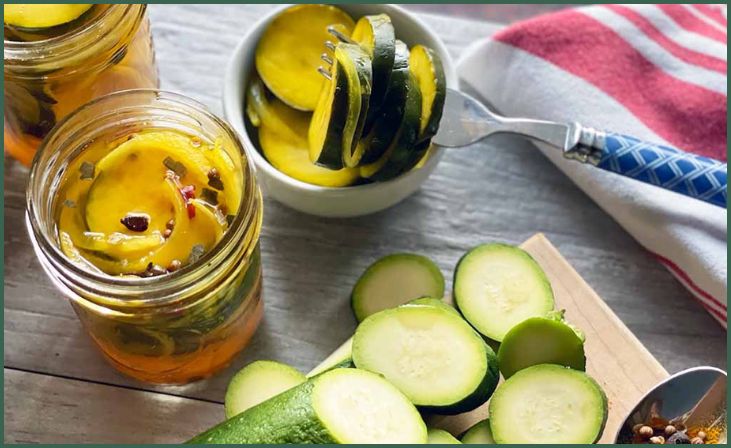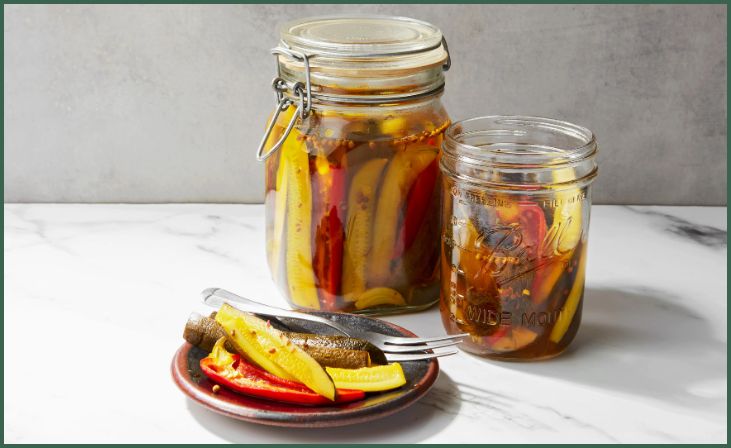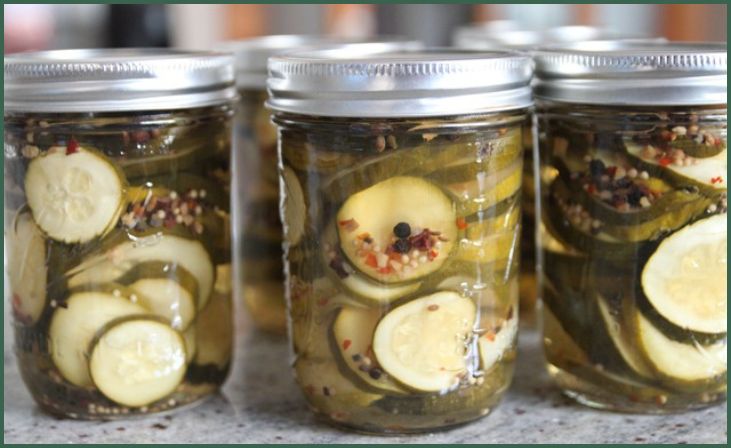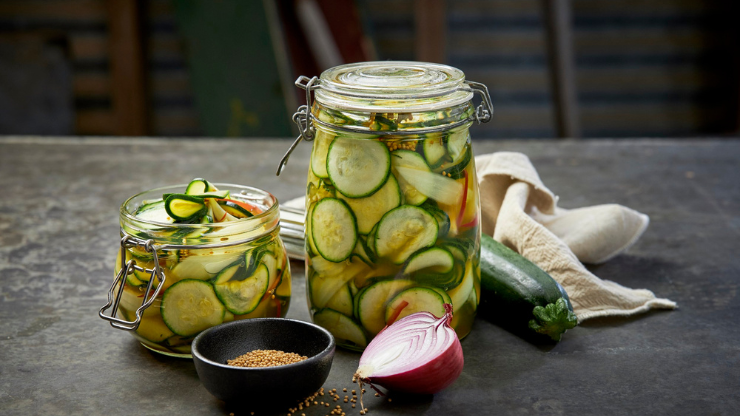If you have a fondness for pickles, get ready for a delightful surprise. Warm Spicy Zucchini Pickles are here to transform your pickle experience, offering a mouthwatering twist on the traditional pickle. These pickles combine the comforting warmth of aromatic spices with the crisp, fresh texture of zucchini, resulting in a flavor sensation that’s truly unique.
In the following sections of this article, we will delve deep into the world of Warm Spicy Zucchini Pickles. We’ll not only unravel the secrets behind their exquisite taste but also provide you with a step-by-step guide on how to craft your very own batch of these delectable pickles. So, whether you’re an avid pickle enthusiast or just someone looking to add a new culinary gem to your repertoire, read on to discover the wonderful world of Warm Spicy Zucchini Pickles.
What Are Warm Spicy Zucchini Pickles?
Let’s delve into the heart of the matter: What exactly are Warm Spicy Zucchini Pickles? These delectable creations are a true culinary delight, fusing the crisp and refreshing nature of zucchinis with a harmonious blend of aromatic spices. The result is a pickle that’s not just your ordinary, run-of-the-mill condiment. Warm Spicy Zucchini Pickles are renowned for their unique flavor profile, one that tantalizes the taste buds with a perfect balance of tanginess and spiciness.
These pickles are a flavorful revelation, and they open the door to a world of culinary adventures. Whether you’re a seasoned cook or an aspiring home chef, adding Warm Spicy Zucchini Pickles to your repertoire will infuse your dishes with a burst of extraordinary flavors, elevating your culinary creations to new heights.
Also Read:- Spicy Pickled Green Beans
Essential Ingredients For Warm Spicy Zucchini Pickles
To embark on your Warm Spicy Zucchini Pickles journey, you’ll need the following ingredients:-
- Fresh zucchinis
- Spices (mention specific spices)
- Vinegar
- Sugar
- Salt
- Garlic
- Onion
The Art of Preparation
Let’s embark on the culinary journey by delving into the art of preparing Warm Spicy Zucchini Pickles. This is where the magic begins:
Preparing Zucchinis:

To ensure that your Warm Spicy Zucchini Pickles turn out just right, it all starts with the selection and preparation of the zucchinis. You’ll learn the art of choosing the freshest zucchinis and how to prepare them for pickling. This crucial step sets the foundation for the delectable flavors that will infuse your pickles.
Creating the Spice Mix:
The secret behind what makes Warm Spicy Zucchini Pickles truly exceptional lies in the perfect blend of spices. In this section, you’ll discover the coveted formula for creating a spice mix that complements the zucchinis’ natural flavors. What’s more, you’ll have the freedom to customize the mix to suit your personal taste, ensuring that your pickles are a reflection of your culinary preferences.
The Pickling Process:

Now, it’s time to walk through the step-by-step pickling process. From brining to jarring your pickles, you’ll gain a comprehensive understanding of each stage of pickling. This process is where the zucchinis absorb the flavors of the spices and undergo the magical transformation into Warm Spicy Zucchini Pickles. We’ll guide you in achieving the ideal balance of flavors, ensuring that your pickles are not just good but absolutely exceptional.
Don't just scroll, subscribe!
BuzzTrail's unique web-stories are the cure for boredom you've been waiting for.
Ways to Enjoy Warm Spicy Zucchini Pickles
When it comes to enjoying Warm Spicy Zucchini Pickles, the possibilities are as vast as your culinary imagination. Here are some enticing ways to savor these delectable pickles:
As a Snack:
Warm Spicy Zucchini Pickles are more than just a condiment; they stand tall as an excellent standalone snack. Their delightful crunch and rich, bold flavor make them the perfect go-to when you’re in the mood for a quick and satisfying treat. Be warned, though, their addictive quality may keep you coming back for more.
On Sandwiches:

Looking to elevate your sandwich game? Look no further. These pickles provide a zesty kick that can transform an ordinary sandwich into a culinary masterpiece. The combination of the pickle’s spiciness and the sandwich’s other ingredients creates a symphony of flavors that will tantalize your taste buds.
With Grilled Meats:
For meat enthusiasts, pairing Warm Spicy Zucchini Pickles with grilled meats is a match made in gastronomic heaven. The zucchinis’ fresh crunch and the pickle’s bold flavors complement the smoky goodness of grilled meats, creating a mouthwatering fusion that will leave your taste buds dancing with joy.
In Salads:
If you’re a salad aficionado, adding Warm Spicy Zucchini Pickles as a topping is a game-changer. These pickles bring a burst of flavor and texture to your salads, taking them to a new level of deliciousness. The tangy and spicy notes of the pickles infuse your greens with excitement, making your salads an irresistible delight.
Warm Spicy Zucchini Pickles: A Must-Try
The Versatility:
Warm Spicy Zucchini Pickles are more than just a condiment; they’re a culinary chameleon, ready to elevate a wide array of dishes. Their versatility knows no bounds, making them a must-try for anyone looking to infuse their meals with an extra burst of flavor. These pickles can be the secret ingredient that transforms your ordinary recipes into extraordinary culinary experiences. Whether you’re preparing a hearty stew, a fresh salad, or even experimenting with a new stir-fry, Warm Spicy Zucchini Pickles will add a tangy and spicy twist that’s sure to impress your palate.
Also Read:- How Long Can You Leave Your Fermented Foods
Homemade Goodness:

One of the remarkable aspects of Warm Spicy Zucchini Pickles is that you can craft them in the comfort of your kitchen. Making your own batch of these pickles gives you complete control over the ingredients, ensuring a wholesome and preservative-free product. With store-bought items, you can never be entirely sure about the quality of the components used. However, by creating these pickles from scratch, you guarantee that you’re using the freshest zucchinis and the highest-quality spices, resulting in a homemade goodness that’s unmatched. The satisfaction of enjoying pickles that you’ve prepared with your own hands is an experience that’s worth every effort.
Conclusion
Warm Spicy Zucchini Pickles bring an exciting twist to traditional pickles. With their enticing blend of flavors and easy-to-follow preparation, they are a must-try for pickle enthusiasts. Whether you enjoy them as a snack, condiment, or part of a larger dish, Warm Spicy Zucchini Pickles will elevate your culinary experience.
Get ready to embark on a pickling adventure, and savor the rich, spicy, and warm goodness of these delectable pickles. Don’t miss out on this delightful addition to your culinary repertoire.
FAQs
Q: Can I adjust the level of spiciness in my pickles?
Q: Can I adjust the level of spiciness in my pickles?
A: Absolutely! You can adjust the spice level by increasing or decreasing the amount of spices used in the recipe.
Q: How long can I store Warm Spicy Zucchini Pickles?
Q: How long can I store Warm Spicy Zucchini Pickles?
A: When properly stored in a cool, dark place, these pickles can last for up to a year.

